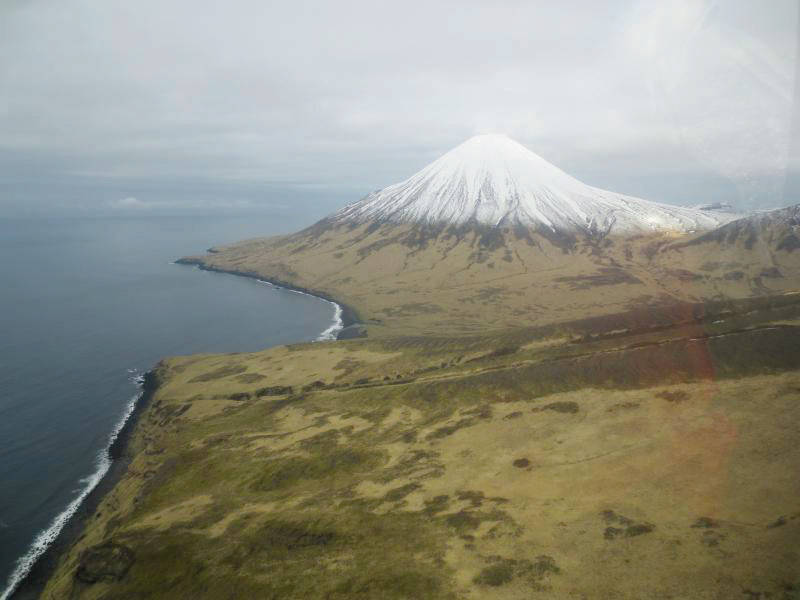Want to win a beer bet? Ask someone the location of the most southerly point in Alaska. The answer isn’t in Southeast, near Ketchikan. Rather, it’s Amatignak Island in the Aleutians. It’s easier to see this on a globe rather than a two-dimensional map, but the central Aleutians are closer to the equator than any other part of Alaska.
Still thirsty? Ask them the most westerly and easterly parts of the 50 states. Those are both in the Aleutian Islands too, since the archipelago extends so far west that it crosses the 180th parallel into the eastern hemisphere.
Specifically, Semisopochnoi Island, near Amchitka, is the most easterly point in the United States when measured by longitude, and our old friend Amatignak is the most westerly.
Of course, if you keep going west from Semisopochnoi, deeper into the eastern hemisphere, you will eventually come to Attu Island, at the end of the United States portion of the island chain (the Aleutian Archipelago continues on to Russia’s Commander Islands).
From Attu you are roughly 1,500 miles from Anchorage but only 600 miles from Petropavlovsk in Russia. Quite reasonably, most people think of Cape Wrangell on Attu as the most westerly point of Alaska, but it’s not when defined by longitude.
All of these islands and geographical trivia sites have something in common: they all comprise part of the Alaska Maritime National Wildlife Refuge. The refuge consists of thousands of islands and a few chunks of mainland, stretching from Forrester Island near the British Columbia border, through the Gulf of Alaska, along the Alaska Peninsula, out to the end of the Aleutians, through the Bering Sea, and all the way to Cape Lisburne in the Chukchi Sea.
While the refuge is far-flung, the headquarters for the refuge is right here on the Kenai Peninsula, in Homer.
Homer is a convenient headquarters for the refuge, not only because it’s a thriving, charming seaside community. Homer also offers a safe, generally ice-free port for the refuge’s ship, the Research Vessel Tiglax, which serves as a sort of combination refuge bush plane and pickup truck, as it is the only means of access to many of the refuge islands.
Since most people find it impossible to reach the remote refuge, the Islands and Ocean Visitor Center in Homer provides a great opportunity to learn about refuge lands and resources. With a virtual seabird colony, historical context, great films and knowledgeable staff, you can get a sense of this refuge of yours right here on the road system.
The human history of these remote lands includes several extraordinary episodes. First settled thousands of years ago, the coastal lands from Southeast to the Aleutian Chain and north to the arctic nurtured rich, vibrant Alaska Native cultures inextricably linked to the ocean, which provided food, transportation and security.
More recently, just as World War II brought the Alcan and forever linked Alaska to the Lower 48, the war also had a powerful impact on refuge islands. World War II swept through the Aleutians, with the refuge islands of Attu and Kiska being captured by the Japanese.
The Battle of Attu was deadly on both sides, not only from opposing forces, but also from the brutal weather which caused misery and death to both infantry and airmen. The battle cost not only the lives of 550 American and 2,500 Japanese soldiers, but also cost the Attu Village residents their homes, their homeland, and, for some, their lives.
Attu Village was captured by Japanese forces and the inhabitants imprisoned in Japan for the duration of the war, where nearly half of them died in captivity. Following the war, the United States government did not allow them to resettle their village on Attu, and instead moved survivors to Atka and other locations.
Later, the Cold War also took a toll on refuge islands, with Amchitka Island being the site of several underground nuclear tests. Today, despite centuries of turmoil and challenges, resilient and talented people remain on and around various refuge lands, from Southeast to the Chuckhi Sea, from the Pribilof Islands to the Alaska Peninsula.
Meanwhile, the extraordinary wildlife that call this refuge home can thrive and carry on with the timeless cycles of nature. Auklets swirl and mingle. Salmon strive for natal streams. Peregrines dive with uncanny precision, while fur seals roar and otters placidly loaf in the kelp.
This splendid array of public lands, just like the Kenai refuge closer to home and public lands all across the country, belong to you, to me, to all of us. These public lands are a gift prior generations of Americans have given to us. This is yours. Your birthright from the past. Yours to enjoy today and tomorrow. Your gift to the future. And your opportunity to win a clever beverage wager with a friend.
Steve Delehanty has served as the Refuge Manager of Alaska Maritime National Wildlife Refuge since 2009. Find more Refuge Notebook articles (1999–present) at https://www.fws.gov/refuge/Kenai/community/refuge_notebook.html.
By STEVE DELEHANTY
Alaska Maritime National Wildlife Refuge

